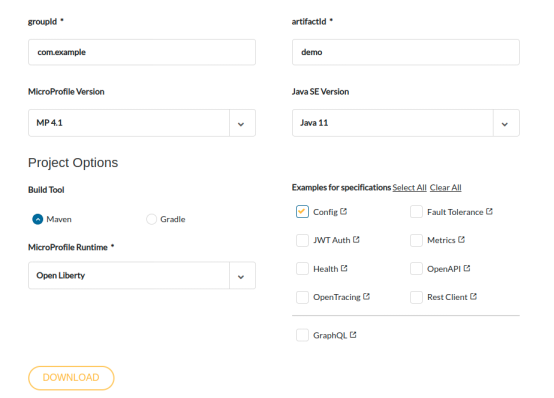译者 | 朱钢
审校 | 孙淑娟
当我们谈论创建可扩展的应用程序时,微服务已经成为一个流行语。但这还不足够,与任何软件架构决策一样,它有一个权衡和几个挑战。幸运的是,对于我们Java开发人员来说,有两种工具的组合使我们的生活更轻松:Microstream和MicroProfile。本文将介绍如何将Microstream和 Open Liberty 结合起来,以创建一个轻松稳定且超快速的微服务应用程序。

具有Open Liberty的微服务
微服务给我们软件工程师带来了一些挑战,特别是作为面对分布式系统的第一步。但这并不意味着我们是孤独的。事实上,有几种工具可以让我们在Java世界中的生活更轻松,尤其是MicroProfile。
MicroProfile的目标是针对微服务架构优化企业版 Java 。它基于Java EE / Jakarta EE标准以及专门用于微服务的API,如Rest Client,Configuration,Open API等。
Open Liberty就是这些实现之一,它以IBM为主要贡献者。Open Liberty 是一个轻量级的开放式框架,用于构建快速高效的云原生 Java 微服务。它为运行云原生应用和微服务提供了足够的运行时。
Microstream的数据持久性非常快
一旦我们谈论微服务,我们就会谈论分布式系统及其挑战,这种谈论在持久性层中将是相同的。
当你有更多关于业务的不确定信息时,我们应该有一个模型,甚至是无模式数据库。尽管如此,持久性层仍然存在很多问题,主要是因为它很难改变。
制作可扩展应用程序的秘诀之一是确保它是无状态的,但我们在持久性层中负担不起它。首先,数据库旨在保留信息及其状态。
使数据持久化层更自然的解决方案之一是直接与 Java 实体作为图形集成。这就是Microstream所做的。
Microstream通过纯Java实现超快的在内存中处理数据。它提供微秒级查询时间、低延迟数据访问、巨大的数据吞吐量和工作负载。因此,它节省了数据中心的大量CPU功耗,二氧化碳排放和成本。
显示代码
让我们将两者结合起来,打造一个超快的微服务。一旦主要目标是展示两者如何结合,我们将选择一个流畅的演示。在此示例中,我们将创建一个简单的 CRUD,其中包含产品、名称和评级,并将其导出为 Rest API。
第一步是创建MicroProfile骨架:它毫不费力且流畅,主要是因为我们可以使用MicroProfile启动器进行可视化配置。配置文件版本 4.1 、 Java 11 和 Open Liberty ,如下图所示

现在有了应用程序的骨架。下一步就是添加Microstream并使两者协同工作。幸运的是,有一个库可以通过CDI扩展集成两者。因此,任何具有CDI和MicroProfile Config的应用程序都可以借助此API工作。
请查看最新版本并将其添加到您的应用程序中。
1. <dependency>
2. <groupId>one.microstream</groupId>
3. <artifactId>microstream-integrations-cdi</artifactId>
4. <version>LAST_VERSION_HERE</version>
5. </dependency>
骨架已设置,因此让我们从代码开始。模型是中心部分。一旦它是一个平滑的示例,我们将创建一个包含几个字段的产品实体。使用Microstream的主要建议是使用不可变实体。因此,我们将创建一个产品作为不可变的实体。
1.public class Product {
2. private final long id;
3. private final String name;
4. private final String description;
5. private final int rating;
6.
7.
8. public Product(
9. ("id") final long id,
10. ("name") final String name,
11. ("description") final String description,
12. ("rating") final int rating
13. ) {
14. this.id = id;
15. this.name = name;
16. this.description = description;
17. this.rating = rating;
18. }
JSON 注释仅告知 MicroProfile 如何将实体序列化为 JSON。
下一步是定义产品集合,我们称之为“库存”。库存类是一组具有多种操作方法的产品。
此类是实体与Microstream引擎之间的链接。与Microstream的连接是使用注释Storage 。
1.import java.util.Collections;
2.import java.util.HashSet;
3.import java.util.Objects;
4.import java.util.Optional;
5.import java.util.Set;
6.import java.util.function.Predicate;
7.
8.import one.microstream.integrations.cdi.types.Storage;
9.
10.
11.
12.public class Inventory {
13. private final Set<Product> products = new HashSet<>();
14.
15. public void add(final Product product) {
16. Objects.requireNonNull(product, "product is required");
17. this.products.add(product);
18. }
19.
20. public Set<Product> getProducts() {
21. return Collections.unmodifiableSet(this.products);
22. }
23.
24. public Optional<Product> findById(final long id) {
25. return this.products.stream().filter(this.isIdEquals(id)).limit(1).findFirst();
26. }
27.
28. public void deleteById(final long id) {
29. this.products.removeIf(this.isIdEquals(id));
30.
31. }
32.
33. private Predicate<Product> isIdEquals(final long id) {
34. return p -> p.getId() == id;
35. }
36.
37.
38. public boolean equals(Object o) {
39. if (this == o) return true;
40. if (o == null || getClass() != o.getClass()) return false;
41. Inventory inventory = (Inventory) o;
42. return Objects.equals(products, inventory.products);
43. }
44.
45.
46. public int hashCode() {
47. return Objects.hash(products);
48. }
49.
50.
51. public String toString() {
52. return "Inventory{" +
53. "products=" + products +
54. '}';
55. }
}
集合准备就绪后,让我们创建存储库。要使用我们的类,我们可以使用 CDI 中的注释。我们需要将此操作提交到将要更改此集合的每个操作中。对于任何更改库存的方法,都有一个InventoryInjectStore注释为我们自动处理它。
1.public interface ProductRepository
2.{
3. Collection<Product> getAll();
4.
5. Product save(Product item);
6.
7. Optional<Product> findById(long id);
8.
9. void deleteById(long id);
10.}
11.
12.
13.
14.public class ProductRepositoryStorage implements ProductRepository {
15. private static final Logger LOGGER = Logger.getLogger(ProductRepositoryStorage.class.getName());
16.
17.
18. private Inventory inventory;
19.
20.
21. public Collection<Product> getAll() {
22. return this.inventory.getProducts();
23. }
24.
25.
26.
27. public Product save(final Product item) {
28. this.inventory.add(item);
29. return item;
30. }
31.
32.
33. public Optional<Product> findById(final long id) {
34. LOGGER.info("Finding the item by id: " + id);
35. return this.inventory.findById(id);
36. }
37.
38.
39.
40. public void deleteById(final long id) {
41. this.inventory.deleteById(id);
42. }
}
最后一步是将此产品公开为 Rest API。然后,我们将使用Jakarta EE API返回MicroProfile:JAX-RS。接下来,我们将使用 MicroProfile 创建 Open API 文档。
1.
2.("products")
3.(MediaType.APPLICATION_JSON)
4.(MediaType.APPLICATION_JSON)
5.public class ProductController
6.{
7.
8. private ProductRepository repository;
9.
10. // TODO don't worried about pagination
11.
12. (summary = "Get all products", description = "Returns all available items at the restaurant")
13. (responseCode = "500", description = "Server unavailable")
14. (responseCode = "200", description = "The products")
15. (name = "BETA", description = "This API is currently in beta state")
16. (description = "The products", responseCode = "200", content = (mediaType = MediaType.APPLICATION_JSON, schema = (implementation = Collection.class, readOnly = true, description = "the products", required = true, name = "products")))
17. public Collection<Product> getAll()
18. {
19. return this.repository.getAll();
20. }
21.
22.
23. ("{id}")
24. (summary = "Find a product by id", description = "Find a product by id")
25. (responseCode = "200", description = "The product")
26. (responseCode = "404", description = "When the id does not exist")
27. (responseCode = "500", description = "Server unavailable")
28. (name = "BETA", description = "This API is currently in beta state")
29. (description = "The product", content = (mediaType = MediaType.APPLICATION_JSON, schema = (implementation = Product.class)))
30. public Product findById(
31. (description = "The item ID", required = true, example = "1", schema = (type = SchemaType.INTEGER)) ("id") final long id)
32. {
33. return this.repository.findById(id).orElseThrow(
34. () -> new WebApplicationException("There is no product with the id " + id, Response.Status.NOT_FOUND));
35. }
36.
37.
38. (summary = "Insert a product", description = "Insert a product")
39. (responseCode = "201", description = "When creates an product")
40. (responseCode = "500", description = "Server unavailable")
41. (name = "BETA", description = "This API is currently in beta state")
42. public Response insert(
43. (description = "Create a new product.", content = (mediaType = "application/json", schema = (implementation = Product.class))) final Product product)
44. {
45. return Response.status(Response.Status.CREATED).entity(this.repository.save(product)).build();
46. }
47.
48.
49. ("{id}")
50. (summary = "Delete a product by ID", description = "Delete a product by ID")
51. (responseCode = "200", description = "When deletes the product")
52. (responseCode = "500", description = "Server unavailable")
53. (name = "BETA", description = "This API is currently in beta state")
54. public Response delete(
55. (description = "The item ID", required = true, example = "1", schema = (type = SchemaType.INTEGER)) ("id") final long id)
56. {
57. this.repository.deleteById(id);
58. return Response.status(Response.Status.NO_CONTENT).build();
59. }
60.
}
就是这样,我们可以测试正在运行的应用程序并检查结果。
1.mvn clean package
2.java -jar target/openliberty-example.jar
3.
4.curl --location --request POST 'http://localhost:8080/products/' \
5.--header 'Content-Type: application/json' \
6.--data-raw '{"id": 1, "name": "banana", "description": "a fruit", "rating": 5}'
7.
8.curl --location --request POST 'http://localhost:8080/products/' \
9.--header 'Content-Type: application/json' \
10.--data-raw '{"id": 2, "name": "watermelon", "description": "watermelon sugar ahh", "rating": 4}'
11.
12.curl --location --request GET 'http://localhost:8080/products/'
13.
curl --location --request GET 'http://localhost:8080/products/1'
我们终于在Open Liberty和Microstream之间实现了集成。本教程展示了两者如何协同工作,并为您提供了一个面对持久性问题的新工具:Microstream。事实上,当你想要创建微服务来超快速运行它时,Microstream和Open Liberty就是伟大的盟友。
译者介绍
朱钢,51CTO社区编辑,2021年IT影响力专家博主,阿里云专家博主,2019年CSDN博客之星20强,2020年腾讯云+社区优秀作者,11年一线开发经验,曾参与猎头服务网站架构设计,企业智能客服以及大型电子政务系统开发,主导某大型央企内部防泄密和电子文档安全监控系统的建设,目前在北京图伽健康从事医疗软件研发工作。
原文标题:Ultra-Fast Microservices in Java: When Microstream Meets Open Liberty,作者:Otavio Santana


































